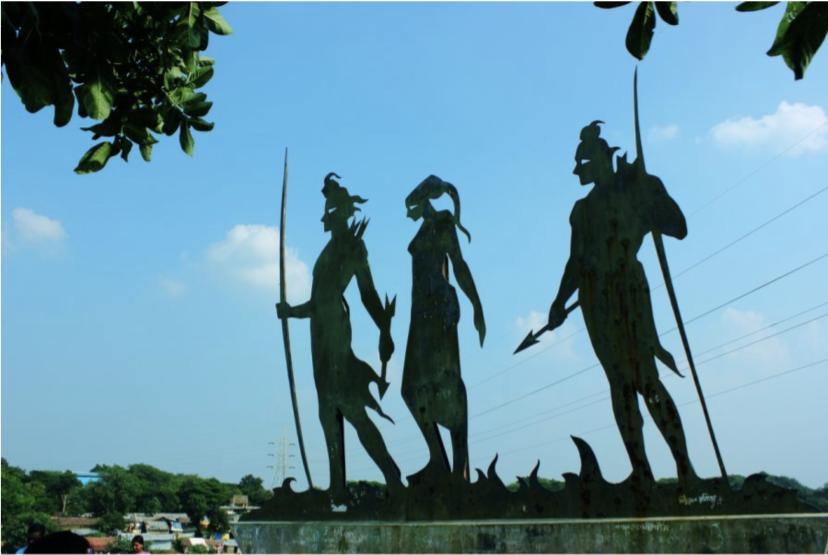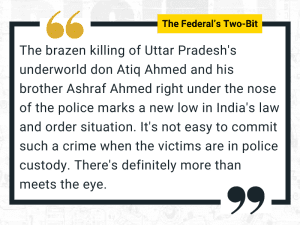
‘Jai Shri Ram’: Gentle greeting, war cry, now passport to assassinate
The act of the three assassins of Atiq Ahmed and his brother Ashraf takes the use of the Jai Shri Ram chant to another level

The on-camera assassination, while in police custody, of Atiq Ahmed, alleged mafia-don and former Uttar Pradesh lawmaker, alongside his brother, Khalid Azim or Ashraf, had remarkable parallels to a scene from the Bhojpuri film, Pakistan Mein Jai Shri Ram, granted an ‘A’ certificate by the Central Board of Film Certification in October 2017.

This film was released in Bihar, Jharkhand and Uttar Pradesh on the eve of Republic Day in 2018 to encash on its heady religio-cultural and nationalistic mix. In these territories, the film was locked in a head-on-head clash with Deepika Padukone-Ranveer Singh-Shahid Kapoor starrer, Padmaavat, which had pre-release run-ins with Hindutva supporters, the sort of trouble this film, as its title suggest, did not have to tackle.
Pakistan Mein Jai Shri Ram was centered on the plight of religious minorities in Pakistan, how they are disallowed from visiting temples and the murder of the priest of a Hindu temple.
Watch: Have police encounters become a political tool for Yogi Adityanath govt?
In the film, the Indian protagonist who gets down to upturning such maltreatment is depicted as a Ram bhakt, or devotee. Along with a bunch of unarmed countrymen chanting Jai Shree Ram, he enters a terrorist den in Pakistan where two young women alongside others are detained after being captured. The terrorists are all killed and the women rescued — one of whom is the romantic foil to the hero while the other is his sister.
Killer of ‘enemies’
The hero carries Ram and Bharat Mata inside his chest figuratively and at every challenging situation ‘rips’ it open to ward off the terrorists.
During the climactic sequence, he also is shown to have transmuted into Ram the God and together with the unarmed lot of his countrymen, kills all ‘enemies’ but not before sermonizing on being faithful, like an Indian (read Hindu), to one woman for seven lives and not be like as Pakistanis (read Muslims) who have affairs with nine women in ‘just a single lifetime’.
Lavlesh Tiwari, Arun Kumar Maurya and Mohit Singh alias Shani, the three who surrendered after murdering the two brothers, rescued no one during their live TV performance. However, like their cinematic role model and the group of Indians in the film, they shouted ‘Jai Shri Ram’ while pumping bullets into the two brothers.
With this synchronised performance — initial police investigations suggest this was staged to secure fame and glory for the trio — the slogan ‘Jai Shri Ram’ traversed the entire arc of being metamorphosed from a daily greeting especially in North India, to a war cry and now to a passport to safety and provide ‘ultra-nationalistic justification’ of nothing but murder, literally in sight of the entire nation.
Watch: How the killing of Atiq and Ashraf Ahmed reflects on UP and India
While investigations in the case are still underway, there exists considerable scepticism if the truth behind their motivation would ever come out. But this is an apt occasion to lament, as well as trace, the usurpation of a greeting that included not just the epic hero, but also acknowledged the eternal presence of his ‘better’ half, Sita, who in the legend weathered challenges and hardships absolutely selflessly — at least till the time the narrative had the need for her character.
An inclusive greeting
‘Glory to Lord Rama’ or ‘Victory to Lord Rama’, what ‘Jai Shri Ram’ means collectively, was not actually rendered in this manner in the pre-Ayodhya agitation era. At that time, it was more inclusive, if one may say.
More inclusive, because the slogan was not raised as a salutation to an individual, and certainly not to a warrior that the Hindutva brigade appropriated after hijacking the daily greeting in the late 1980s and early 1990s.
Initially, there were two styles of regular invocations of Ram, besides Hey Ram, a form of bemoaning or sighing. There is little need to recapitulate the two words that are believed to have escaped Mahatma Gandhi‘s lips after Nathuram Godse pumped bullets into his chest.
Of the two ways where Ram’s name figures in everyday exchanges, the first was its use as a pleasantry between people who knew one another or were complete strangers. This expression was ‘Ram-Ram’, ‘Jai Ram Ji Ki’ or as ‘Jai Siya Ram’, something very similar to Namaskar, Nomoshkar or Vanakkam.
Whenever there was a need for a salutation to Ram, say on religious festivals, or in chorus, forms were again two; significantly not Ram in the singular, but with Sita: ‘Bol Siyavar’ or ‘Siyapat Ramchandraji ki jai’ (Victory to Ramchandra, Sita’s husband).
Ayodhya: then and now
There was no aggression in these chants. Visits to Ayodhya in the initial years revealed numerous pillars and plaques bearing names of both Ram and Sita.
Analysis | From Jai Shri Ram to Hanuman Chalisa: The evolving Hindutva tool-kit
Gradually, as the Ram temple agitation gained strength, public depiction of Ram’s character evolved from the non-violent benevolent king to a warrior because the Sangh Parivar could not use a ‘non-macho’ Ram as a political prop.
In countless narratives in different languages across India and even outside, Ram comes across as a tender and humanistic character, unlike the warrior-like all-conquering king and defender of national honour from the Hindu nationalist discourse.
Prior to the rise of the Ram Janmabhoomi agitation from 1984 onward, Ram existed in the nation’s political discourse but not as a character, complete allegiance to whom would be a test of loyalty. He was the humanising character who provided the perfect and much-aspired rule or Ram Rajya as popularised by Gandhiji though his assertions and imaginations.
The alteration from ‘Jai Siya Ram’ to ‘Jai Shri Ram’ underscored several developments: Colloquial language of the previous greeting being altered to a Sankritised battle cry, elimination of the feminine to a more sure-footed patriarchal notion of Ram the saviour and hero, and induction of Ram in the Hindutva political vocabulary. The last enabled use on Ram in politics because ‘restoring’ the temple to deify him in Ayodhya was presented as a matter of national dignity.
Berating Muslims
For the first few years, ‘Jai Shri Ram’ shouted in a full-throated manner was used to mark presence of the agitation, indicate its increasing militancy, berate the Muslims and as a chant to enthuse the cadre.
Opinion | Getting healthcare right: Learning from Rajasthan’s confrontation with hospitals
In my 1994 book, The Demolition: India At the Crossroads, I wrote: “Jai Shri Ram had been given the connotation of a battle cry. It became the marching words of a community on the move, and was mouthed by the kar sevaks while they made their way to the temple town through the fields adjoining the town and later while launching the assault on the Babri Masjid on October 30 (1990) and while ravaging a few Muslim houses on the outskirts of Ayodhya.”
“The slogan had also been similarly used during LK Advani’s Rath Yatra, and coupled with images of the BJP leader atop the modern chariot replete with bow and arrow, generated powerful images of a community that was no longer willing to take things lying down. The slogan was matched by the use of saffron bandannas with the slogan printed over it, and it virtually became the new uniform for the RSS clan.”
For some years after the demolition, the slogan fell into disuse or very rarely use. However, the Ram temple movement was not indicted and the demand was considered as a legitimate one. Moreover, after the demolition, everyone believed that it was just a matter of time before a new temple would be built.
A moment of legitimising the Ram temple movement and Jai Shri Ram slogan was evident in 1994 with the release of the romantic musical film Hum Aapke Hain Kaun, starring Salman Khan and Madhuri Dixit. A temple is shown in the film and it has Jai Shri Ram painted on the walls.
This marked the normalisation of the slogan insofar as popular culture was concerned.
VHP factor
The agitation came back into public eye in a big way in 2002 when the Vishwa Hindu Parishad resurrected the temple construction programme and asked kar sevaks to gather at the temple town.
Jai Shri Ram made a comeback and it was this chant which sparked the disturbance at Godhra station which changed the course of Indian history, and boosted the sagging political career of Prime Minister Narendra Modi, then the chief minister of Gujarat. Post-Godhra, ‘Jai Shri Ram’ emerged as a form of cocking a snook at the Muslims besides being the marching slogan as earlier.
Sometime after Modi became Prime Minister, activists of the Sangh Parivar, formally allied and those on its periphery, started chanting the slogan while lynching people who were alleged to have been either storing consuming or trading in beef. Hereon, people began using the Ram as a form of extracting loyalty and also as a tool to heckle the opponents.
This was done most glaringly in June 2019 after the BJP secured a renewed mandate in the parliamentary elections. On June 18, BJP MPs heckled members of the Opposition, especially Muslims, by constantly chanting Jai Shri Ram. At around the same time, mobs attacked Muslim men in places as diverse from Assam to Jharkhand. The target in Jharkhand died, as did a Muslim in West Bengal. But these were all instances of mob violence in which a cornered victim was forced to chant Ram’s name.
In recent years, provocative processions taken out by Hindu groups during the festival of Ram Navami has resulted in communal clashes in West Bengal. Prior to the political advent of the BJP, the people of the state were not known to be devotees of Ram. Activists of the BJP used Jai Shri Ram slogan to deride Mamata Banerjee on several occasions.
Atiq’s assassins
The act of the three assassins of Atiq Ahmed and his brother, however, takes the use of the ‘Jai Shri Ram’ slogan to another level. They not just killed in the name of Ram but also chanted the slogan to identify with the dominant political culture and party in the country. Their hope is that by chanting the slogan, their crime will be eventually condoned, or at least their families would benefit greatly.
(The writer is an NCR-based author and journalist. His latest book is The Demolition and the Verdict: Ayodhya and the Project to Reconfigure India. His other books include The RSS: Icons of the Indian Right and Narendra Modi: The Man, The Times. He tweets at @NilanjanUdwin)
(The Federal seeks to present views and opinions from all sides of the spectrum. The information, ideas or opinions in the articles are of the author and do not necessarily reflect the views of The Federal)


